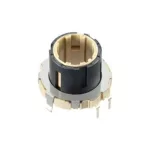
Introduction
The Internet of Things (IoT) has undoubtedly been a transformative force in connecting billions of devices worldwide and revolutionising various industries. However, ensuring seamless communication and connectivity among diverse IoT devices remains a significant challenge. Multiprotocol wireless modules serve as a promising solution in this regard, enabling efficient data exchange and interoperability across various protocols. This article outlines the significance of multiprotocol wireless modules in the context of IoT connectivity, focusing on their advantages and upfront challenges with possible considerations.
Multiprotocol Wireless Modules: A Brief Introduction
Multiprotocol wireless modules are compact electronic hardware components designed to support multiple wireless communication protocols simultaneously within a single hardware module. These modules integrate multiple communication standards like Bluetooth, Wi-Fi, Zigbee, Thread, etc., allowing IoT devices to communicate with diverse ecosystems. Switching between protocols dynamically will enable developers to design products capable of communicating with a plethora of devices and systems without using separate modules for each protocol.
The Growing Importance of Multiprotocol Wireless Modules in IoT
The IoT ecosystem covers a myriad of devices, each utilising different communication protocols. As a result, achieving seamless interconnectivity and data exchange among these devices becomes complex and resource-intensive. Multiprotocol wireless modules have been popularised due to their ability to handle multiple communication protocols simultaneously, enabling cross-platform communication and bridging the gap between heterogeneous devices. In addition, bespoke modules are significant in terms of creating flexible, adaptable, and efficient IoT solutions, addressing the challenges.
Understanding the Multiprotocol Advantage: The Impact on IoT Connectivity
Multiprotocol wireless modules offer unparalleled benefits in IoT connectivity, such as:
- Interoperability and Flexibility
Multiprotocol wireless modules serve as a bridge–facilitating communication between devices operating on different protocols. This interoperability improves the IoT networks’ overall flexibility, allowing new device integration without major infrastructure changes. Manufacturers can develop products that support multiple protocols, ensuring compatibility with existing and future IoT ecosystems.
- Enhanced Communication Range and Coverage
Different communication protocols offer varying ranges and coverage capabilities. By integrating multiple protocols into a single wireless module, IoT devices can leverage the strengths of each protocol to extend their communication range and improve coverage. This flexibility is precious for applications requiring comprehensive area coverage or facing obstacles such as walls and buildings.
- Increased Reliability
Reliability is critical in IoT applications, particularly in sectors like healthcare, industrial automation, and transportation. Multiprotocol wireless modules can significantly improve reliability by providing redundant communication paths. If one protocol experiences interference or disruption, the module can seamlessly switch to an alternate protocol, ensuring uninterrupted data flow. This dynamic failover mechanism enhances the robustness of the IoT network.
- Efficient Power Management
Multiprotocol wireless modules can dynamically switch between protocols based on the specific IoT application requirements. For instance, power-hungry protocols like Wi-Fi can be activated when high data transfer rates are needed. In contrast, low-power protocols like Zigbee or Bluetooth can handle tasks with minimal data requirements. This intelligent power management helps optimise the energy consumption of IoT devices, prolonging their battery life and reducing operational costs.
- Future-Proofing IoT Deployments
The landscape of IoT communication protocols is continually evolving, bringing about improved features and performance. Multiprotocol wireless modules offer future-proofing capabilities, as they can adapt to support new protocols through firmware updates, thereby extending the lifespan of IoT deployments and mitigating obsolescence.
Multiprotocol Wireless Modules for IoT Connectivity: Challenges and Considerations
Though multiprotocol wireless modules offer a wide range of benefits, they also have certain challenges. Understanding these challenges can positively impact solutions and essential considerations for their effective and reliable performances. Some of the challenges with possible considerations include:
- Complexity and Development Efforts
Designing and implementing multiprotocol wireless modules require substantial engineering efforts and expertise. Developers must handle the intricacies of multiple protocols, manage protocol switching efficiently, and ensure reliable data exchange across diverse devices. The complexity can lead to longer development cycles and increased costs.
- Radio Frequency (RF) Interference
Running multiple communication protocols on a single device may result in RF interference, particularly when operating on similar frequency bands. This interference can degrade signal quality affecting overall system performance. The possible solutions for mitigating RF interference involve careful hardware and firmware design and effective testing procedures.
- Security Considerations
Multiprotocol wireless modules can introduce potential security risks due to their vulnerability to increased attacks, potentially affecting multiple protocols operating simultaneously. Robust security measures, including encryption, authentication, and secure key exchange, can safeguard IoT networks using multiprotocol wireless modules.
Final Remarks
The development and implementation of multiprotocol wireless modules have significantly enhanced the landscape of IoT connectivity. These modules have proven to be a game-changer, providing a versatile and efficient solution to connect IoT devices seamlessly across various networks. The ability to support multiple communication protocols enables greater flexibility, scalability, and compatibility, addressing the diverse needs of IoT applications. All stakeholders must embrace these advancements and work together to shape a more connected, secure, and intelligent IoT landscape for the benefit of society as a whole.




















